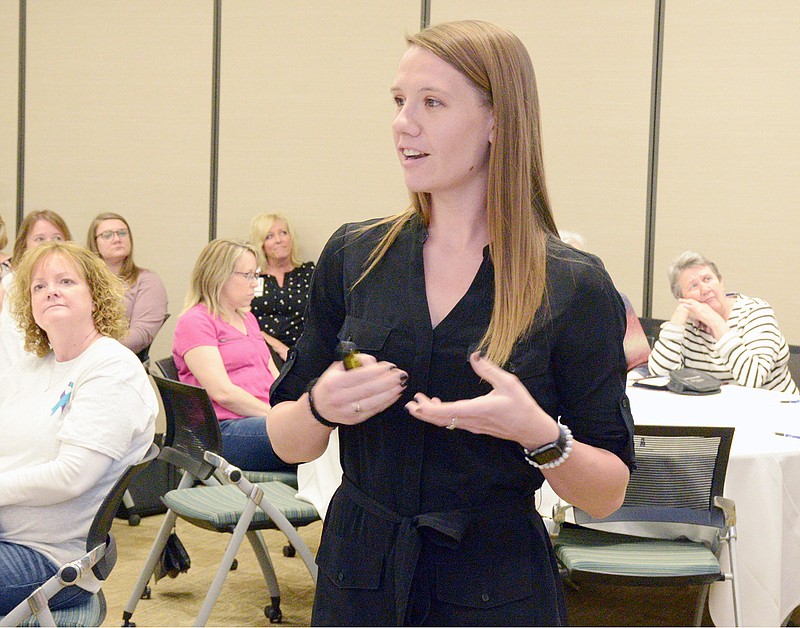Adults twice Tuesday filled almost to capacity a program aimed at training adults to recognize the signs of suicide in children and youths.
The Anne Marie Project and In A Flash partnered with St. Mary's Hospital to present a discussion designed to train adults, teachers, parents and guardians about the signs of suicide and how the adults might save lives.
The Anne Marie Project - a coalition that provides resources to help young people find information and guidance on challenges they face - and In A Flash - a nonprofit that strives to prevent suicide through education and heightened awareness while uniting survivors and providing support to those affected by suicide in local communities - brought in Colleen Pace, suicide prevention manager for Communities Healing Adolescent Depression and Suicide (CHADS), the St. Louis-based coalition for mental health.
The family of Chad McCord established the coalition in early 2005, less than a year after the 18-year-old high school senior's suicide.
McCord suffered from depression as well as anxiety, obsessive-compulsive and bipolar disorders.
Shortly before his death - which was about a month before he was due to graduate - he told his parents if he had cancer, other students would have rallied around him, made posters of him and given him a hero's welcome. However, since he had mental illness, the Eagle Scout and star athlete worried other students would shy away from him or think he was weird.
"His parents decided to turn this tragedy into a legacy," Pace said. "They knew that if we talked about this more, if we taught people what to look for and how to ask for help - and reduced that stigma - that hopefully, the number of suicide deaths goes to zero."
Every year, the coalition speaks to Missouri students, Pace said.
Consistently, of the students the coalition makes presentations to, 14.8 percent ask to speak to counselors, Pace said. In calendar year 2018, CHADS spoke with some 35,700 students, and 7,043 made the requests, either for themselves or a friend.
"We're going to talk about what to do - how to have a conversation with a youth or an adolescent that you're concerned about," she said. "And then, how do we take care of ourselves after we have that conversation, because self-care is an incredibly important part of mental health and doing this work."
Pace shared data from the Centers for Disease Control and Prevention's (CDC) Youth Risk Behaviors Surveillance System. The system (which is updated every two years) monitors six categories of health-related behaviors that contribute to the leading causes of death and disability among youth and adults, according to the CDC website.
Results from 2016 showed 29.9 percent of Missouri middle school students "felt so sad or hopeless for two-plus weeks that they stopped doing some usual activity," 10.4 percent "seriously considered attempting suicide (within the previous 12 months)," 7.1 percent "made a plan about how they would attempt suicide," 5.1 percent "attempted suicide (one or more times within the previous 12 months)," and .8 percent "attempted suicide that resulted in an injury that needed to be treated by a doctor or nurse."
One in five adolescents have a diagnosable mental health disorder, Pace said.
"About 33 percent of those start to manifest during those adolescent years," she said. "So, while they're going through puberty and have all of this other stuff going on, they may actually have signs or symptoms of an actual mood disorder of some sort."
About 60 percent of adolescents with mood disorders are not receiving treatment. The prevalence of depression in adolescents and young adults is increasing. It was 8.7 percent in 2006, 11.3 percent in 2014 and 12.8 percent in 2016, according to data from the CDC.
For someone to be diagnosed with clinical depression, Pace said, they have to show five symptoms for two consecutive weeks or more. Those symptoms are:
Angry, irritable, hostile or aggressive
Problems with sleeping (too much, too little or disturbed)
Loss of interest in usual activities/things they used to enjoy
Physical pain (headaches, stomach aches)
Change in weight or appetite
Feelings of sadness
Excessive isolation
Most of the symptoms look like typical teenage behaviors.
"How do we know that there's a difference?" Pace asked. "If you have a child in your life, you know them better than most people do.
"You know that child in your life better than most people do. So, trust your gut."

